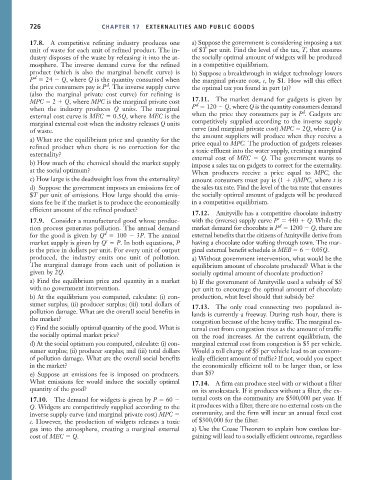Page 752 - Microeconomics, Fourth Edition
P. 752
c17ExternalitiesandPublicGoods.qxd 8/22/10 4:56 AM Page 726
726 CHAPTER 17 EXTERNALITIES AND PUBLIC GOODS
17.8. A competitive refining industry produces one a) Suppose the government is considering imposing a tax
unit of waste for each unit of refined product. The in- of $T per unit. Find the level of the tax, T, that ensures
dustry disposes of the waste by releasing it into the at- the socially optimal amount of widgets will be produced
mosphere. The inverse demand curve for the refined in a competitive equilibrium.
product (which is also the marginal benefit curve) is b) Suppose a breakthrough in widget technology lowers
d
P 24 Q, where Q is the quantity consumed when the marginal private cost, c, by $1. How will this effect
d
the price consumers pay is P . The inverse supply curve the optimal tax you found in part (a)?
(also the marginal private cost curve) for refining is
MPC 2 Q, where MPC is the marginal private cost 17.11. The market demand for gadgets is given by
d
when the industry produces Q units. The marginal P 120 Q, where Q is the quantity consumers demand
d
external cost curve is MEC 0.5Q, where MEC is the when the price they consumers pay is P . Gadgets are
marginal external cost when the industry releases Q units competitively supplied according to the inverse supply
of waste. curve (and marginal private cost) MPC 2Q, where Q is
the amount suppliers will produce when they receive a
a) What are the equilibrium price and quantity for the price equal to MPC. The production of gadgets releases
refined product when there is no correction for the a toxic effluent into the water supply, creating a marginal
externality?
external cost of MEC Q. The government wants to
b) How much of the chemical should the market supply impose a sales tax on gadgets to correct for the externality.
at the social optimum? When producers receive a price equal to MPC, the
c) How large is the deadweight loss from the externality? amount consumers must pay is (1 t)MPC, where t is
d) Suppose the government imposes an emissions fee of the sales tax rate. Find the level of the tax rate that ensures
$T per unit of emissions. How large should the emis- the socially optimal amount of gadgets will be produced
sions fee be if the market is to produce the economically in a competitive equilibrium.
efficient amount of the refined product?
17.12. Amityville has a competitive chocolate industry
s
17.9. Consider a manufactured good whose produc- with the (inverse) supply curve P 440 Q. While the
d
tion process generates pollution. The annual demand market demand for chocolate is P 1200 Q, there are
d
for the good is given by Q 100 3P. The annual external benefits that the citizens of Amityville derive from
s
market supply is given by Q P. In both equations, P having a chocolate odor wafting through town. The mar-
is the price in dollars per unit. For every unit of output ginal external benefit schedule is MEB 6 0.05Q.
produced, the industry emits one unit of pollution. a) Without government intervention, what would be the
The marginal damage from each unit of pollution is equilibrium amount of chocolate produced? What is the
given by 2Q. socially optimal amount of chocolate production?
a) Find the equilibrium price and quantity in a market b) If the government of Amityville used a subsidy of $S
with no government intervention. per unit to encourage the optimal amount of chocolate
b) At the equilibrium you computed, calculate: (i) con- production, what level should that subsidy be?
sumer surplus; (ii) producer surplus; (iii) total dollars of 17.13. The only road connecting two populated is-
pollution damage. What are the overall social benefits in lands is currently a freeway. During rush hour, there is
the market? congestion because of the heavy traffic. The marginal ex-
c) Find the socially optimal quantity of the good. What is ternal cost from congestion rises as the amount of traffic
the socially optimal market price? on the road increases. At the current equilibrium, the
d) At the social optimum you computed, calculate: (i) con- marginal external cost from congestion is $5 per vehicle.
sumer surplus; (ii) producer surplus; and (iii) total dollars Would a toll charge of $5 per vehicle lead to an econom-
of pollution damage. What are the overall social benefits ically efficient amount of traffic? If not, would you expect
in the market? the economically efficient toll to be larger than, or less
e) Suppose an emissions fee is imposed on producers. than $5?
What emissions fee would induce the socially optimal 17.14. A firm can produce steel with or without a filter
quantity of the good? on its smokestack. If it produces without a filter, the ex-
17.10. The demand for widgets is given by P 60 ternal costs on the community are $500,000 per year. If
Q. Widgets are competitively supplied according to the it produces with a filter, there are no external costs on the
inverse supply curve (and marginal private cost) MPC community, and the firm will incur an annual fixed cost
c. However, the production of widgets releases a toxic of $300,000 for the filter.
gas into the atmosphere, creating a marginal external a) Use the Coase Theorem to explain how costless bar-
cost of MEC Q. gaining will lead to a socially efficient outcome, regardless

